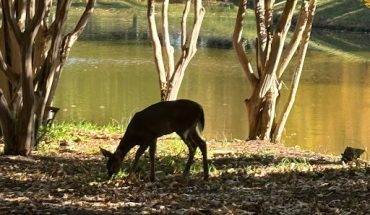BY EMILY VERBIEST, STAFF WRITER
Formidable yet inviting, Emilie Brzezinski’s lofty wood sculptures elegantly tower over onlookers in the Fine Arts Gallery. The room’s glossy grey floors and sleek white walls create an industrial atmosphere that sharply contrasts the rugged and organic wooden textures of Brzezinski’s pieces, resulting in an especially enticing exhibit. From now until Oct. 7, Mason’s School of Art is hosting “Natural Fact,” an exhibit showcasing various pieces from Brzezinski’s 40-year career as a sculptor.
Currently a resident of McLean, Virginia, Brzezinski was born in Switzerland but moved to the United States during World War II. After being raised in California, she earned an art history degree from Wellesley College in 1953 and began her artistic career in the 1970s. Armed with tools such as chainsaws and axes, her work centers around the usage of wood to create immense, raw and striking pieces of art.
While utilizing the timeless allure of nature, Brzezinski creates wooden pieces that remain true to their natural form. She intentionally avoids over-transforming the natural objects she works with in order to allow the pieces to speak for themselves. Brzezinski unearths the essence of the wood’s history by sawing, carving and cutting while maintaining the tree’s original outline. As an artist, she does not exert absolute dominance over the natural materials she uses, but instead works jointly with the wood to extract meaning.
Don Russell, the university curator, explained how the basis of Brzezinski’s process lays in nature awareness and being able to communicate with the natural materials.
“She really asks the tree what meaning is inside it and she is just following and having a conversation with the tree, using a chainsaw,” Russell said.
The exhibit’s underlying theme relates to transcendentalism, which greatly reveres nature’s intrinsic value. Exhibitions Specialist Jeff Kenney described how this perspective is reflected in Brzezinski’s approach to art.
“With her work, it’s this concept of truth to materials, where you leave a lot raw and it’s not glazed or painted or colored, just reducing the art to the form of a simple line or a simple wedge.”
“Natural Fact” shows Brzezinski’s evolution as an artist by displaying several pieces from her earlier, more experimental years as a sculptor. An intriguing glass figure from 1979 titled “Transparent Object #2” and a sculpture titled “The Mold as a Piece of Art” from 1982 fall under the category of her exploratory work.
Russell explained how “The Mold as a Piece of Art” was created by covering a tree with rubber foam, then peeling it off, leaving a raw impression on the foam. Innovative experiments such as that would guide Brzezinski to her future work.
“A lot of these were experiments, she had a question so she came up with an experiment and this is the result. It was like a sketch, in a sense, for the later work,” Russell said.
Despite the variations in her work, all of Brzezinski’s pieces possess a similar sense of vigor and liveliness, much like her character.
“She’s a force,” Russell, who has known Brzezinski for more than thirty years, said. “She is graceful but also penetrating and investigatory. These [pieces] are all investigations of a tree, and of nature. She is incredibly dignified but also very warm. It’s an amazing combination.”
Brzezinski’s work is undoubtedly driven by a deep love of nature. Consequently, her spirited vision has produced magnetic pieces of art.
Russell said, “people are naturally drawn to it. As humans, we all have a strong desire to connect or reconnect with nature, natural objects or naturally rendered things, especially in this era where everything is mediated through a screen. … Artwork opens a space where people can consider different ideas, different things than what’s already in their heads. Art is an opportunity for learning.”
The captivating exhibit almost acts as an on-campus sanctuary or a tranquil retreat. On a quiet Monday afternoon, sophomore Aekta Bandodker strolled through the exhibit admiring the pieces. When asked for her opinion on the art she pointed to the “Cherry Breezes” piece, a stunning redwood sculpture that bends at the core to create the illusion of movement, she said, “It looks like the wind is blowing in the trees.”
Bandodker then pointed at the “Two Poplar Cores” piece, which resembles a battered shell and said, “it looks like an open acorn, it reminds me of “Alice and Wonderland.” Everything in here is so peaceful. … The more time I spend in here, the more things I notice and I don’t want to leave, it’s such a great escape.”


